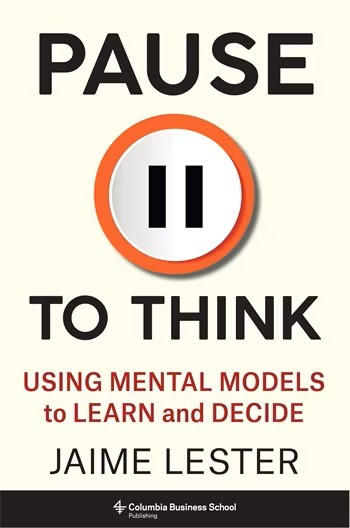Pause to Think: Using Mental Models to Learn and Decide. 2024. Jaime Lester. Columbia Business School Publishing.
Pause to Think offers a perfect balance of light and serious reading. It is direct, delightful, and articulate in suggesting specific ways to improve approaches to anything we attempt to do. The author presents mental models in accessible, entertaining ways that prove both memorable and immediately useful.
Jaime Lester is a hedge fund industry veteran and an adjunct professor at Columbia Business School. He has divided this powerful book into two sections — Part I: Important Concepts and Part II: Important Frameworks — with an interlude. He suggests we take a slow rather than fast approach to getting things thoughtfully done. Being human means being imperfect. Using this awareness, we can counteract impetuous actions and biases. Consistency and that overused word, “mindfulness,” should reduce flawed outcomes.
The identification of many of the cognitive biases discussed by Lester is rooted in investment research, particularly in the behavioral finance discipline that emerged in the 1970s. According to behavioral finance, human psychology and emotion cause fluctuations in securities prices, which are often determined irrationally. The rise of robo-advisors is frequently described as a solution to these biases, intended to compel investors to assess their risk, determine their most suitable allocation, and stick to the program.

At the conclusion of each section in Part I, the author offers some exercises to try. They involve excellent thought questions on topics such as investing and science, economics and business, and probability and statistics. I found that these reinforced the concepts discussed and enabled me to evaluate my own biases. Some of the exercises also assess basic mathematical literacy. Try them and you will find that the lessons are worthy of mastering. Have a calculator at hand if your mental math is rusty.
If your eyes are too tired to read, or you choose to give Lester’s excellent narrative a break, turn to the adorable illustrations by Albertus Ang Hartono, aka Everwinter, that emphasize the intent of the book. You will capture the book’s sense of porpoise! See the illustration on p. 127, in connection with efficient learning, to understand this seabound-mammal reference.
In Part II of the book, Lester is unreservedly opinionated in addressing important frameworks for investing. Most readers will fully agree with his five keys to successful investing but will argue with his recommendations, such as ignoring the value of the investment portfolio, setting up automatic savings and investment options, and avoiding all high-fee investment products.
Micromanaging or over-policing values does not make sense, but periodic review of the asset allocation and holdings certainly does. Setting up automatic savings and investment options must include some flexibility associated with risk tolerance and liquidity requirements that can change when one least expects. “Set it and forget it” does not fulfill the needs of responsible, prudent investors. And lastly, fees of considerable size could be justified, based on the investment product and its objectives. One would not expect to pay much at all for a passive exchange traded fund but would expect to pay a premium fee for a special-purpose hedge fund.
Lester repeats and emphasizes that “you will make more money choosing stocks randomly than paying a professional investor to choose them for you” (p. 160). Many clients of investment advisors are nonetheless required to employ professional managers, or else they are unskilled or time-constrained and admit they need help from a professional. The investment professional coaches and converses with the investor, provides a sounding board for investment concerns, manages expectations, and consistently delivers performance reports to ensure that the investment program is on track with its agreed-upon objective.
But fear not! Lester brings the book to a truly bullish conclusion, addressing the framework of happiness. His focus is on professional happiness that evolves into happiness, period. He encourages us all, young and aging, to reduce time and energy devoted to activities that are unlikely to make us happy, including seeking the perfect job. Increase time and energy, the author urges, toward activities that are likely to make us happy.
My favorite of Lester’s prescriptions for maximizing happiness is to maintain an appropriate context and perspective by incorporating mindfulness and gratitude in the daily routine. As I pause to think why this is so important, I turn to our universal pandemic experience and its outcome for each of us, personally and professionally. I think that Lester has struck gold in delivering a unique book that touches the minds and hearts of investment professionals — one that we all should pause to read.
